|

All Things Considered
host Lorna Benson
To close out the millennium,
Minnesota Public Radio's All Things Considered presents a look back at life
in Minnesota in 1900. Each month, we'll paint a picture of important events,
ideas and life experiences 99 years ago. The series can be heard during All
Things Considered on the last Monday of each month.
|
 |
|
The End
December
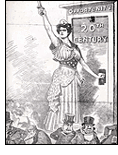 Before radio, TV and the Internet, people got their news from the daily papers. Breaking stories clattered across the wires to newspaper offices around the country.
In Minneapolis and St. Paul, two pennies bought you one of four daily papers. What stories made the Twin Cities papers 100 years ago this month? Grab your slippers, find a comfortable chair and your favorite coffee mug for our final edition of the Minnesota Century series.
Before radio, TV and the Internet, people got their news from the daily papers. Breaking stories clattered across the wires to newspaper offices around the country.
In Minneapolis and St. Paul, two pennies bought you one of four daily papers. What stories made the Twin Cities papers 100 years ago this month? Grab your slippers, find a comfortable chair and your favorite coffee mug for our final edition of the Minnesota Century series.
|
|
|
An Early Leader
November
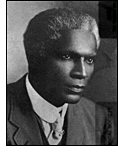 The turn of the century was a troubling, violent time for African-Americans in this country. Just decades after the end of slavery, blacks faced widespread discrimination, barriers to voting, and the terror of lynch mobs.
Frederick McGhee was a little-known figure whose life as a civil-rights advocate set the stage for this century's most influential black civil rights organization: the NAACP.
The turn of the century was a troubling, violent time for African-Americans in this country. Just decades after the end of slavery, blacks faced widespread discrimination, barriers to voting, and the terror of lynch mobs.
Frederick McGhee was a little-known figure whose life as a civil-rights advocate set the stage for this century's most influential black civil rights organization: the NAACP.
|
|
The Story of Cole Younger
October
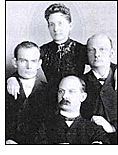 When the Minnesota prison in Stillwater went up in flames, the warden needed help evacuating the female prisoners. He handed a revolver to a confessed murderer, the man who, with Jesse James, led the Northfield Raid, one of the bloodiest bank robberies in Minnesota history.
When the Minnesota prison in Stillwater went up in flames, the warden needed help evacuating the female prisoners. He handed a revolver to a confessed murderer, the man who, with Jesse James, led the Northfield Raid, one of the bloodiest bank robberies in Minnesota history.
The year was 1884 and the prison was Stillwater, Minnesota. The prisoner with a gun was the notorious outlaw Cole Younger, the charismatic bank robber who the nation made into a legend because of its fascination with the untamed western frontier.
|
September
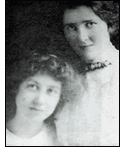 In 1940, Maud Hart Lovelace brought her Mankato, Minnesota childhood to
life in
a book she called "Betsy-Tacy." It was her first book for children, and as it
turned out, her first big success. Ten books and 15 years later, Maud
had 20 years of her life documented in the Betsy-Tacy series and fans
around the world were tuned into to the intricacies of small-town life at the turn of the century.
In 1940, Maud Hart Lovelace brought her Mankato, Minnesota childhood to
life in
a book she called "Betsy-Tacy." It was her first book for children, and as it
turned out, her first big success. Ten books and 15 years later, Maud
had 20 years of her life documented in the Betsy-Tacy series and fans
around the world were tuned into to the intricacies of small-town life at the turn of the century.
|
|
August
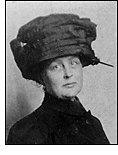 One of the few occupations open to young women at the end of the 19th century was teaching in one of the one-room schoolhouses that dotted the landscape of rural Minnesota.
One of the few occupations open to young women at the end of the 19th century was teaching in one of the one-room schoolhouses that dotted the landscape of rural Minnesota.
|
July
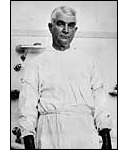 The Mayo clinic is Minnesota's most famous medical institution.
But, just over 100 years ago, at a time when many people still called hospitals "death houses", Doctors Will and Charles Mayo were building a successful surgical practice out of a three-room office in an unlikely location: a frontier town called Rochester, Minnesota.
The Mayo clinic is Minnesota's most famous medical institution.
But, just over 100 years ago, at a time when many people still called hospitals "death houses", Doctors Will and Charles Mayo were building a successful surgical practice out of a three-room office in an unlikely location: a frontier town called Rochester, Minnesota.
|
June
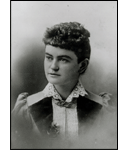 Here is the story of journalist Eva McDonald. Her work exposing the harsh conditions endured by women in the new factories propelled her into the forefront of the very male world of labor politics.
Here is the story of journalist Eva McDonald. Her work exposing the harsh conditions endured by women in the new factories propelled her into the forefront of the very male world of labor politics.
|
|
May
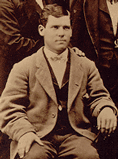 In the late 1880s, three brothers from Duluth set out to prove a rumor that the Mesabi district in northern Minnesota was rich with iron ore. In just a few months, the Merritt brothers discovered the tip of what turned out to be the most valuable ore deposit in the United States. But instead of getting rich, the brothers lost all their money, and surrenderd every one of their valuable mines to an eastern oil tycoon named John D. Rockefeller.
In the late 1880s, three brothers from Duluth set out to prove a rumor that the Mesabi district in northern Minnesota was rich with iron ore. In just a few months, the Merritt brothers discovered the tip of what turned out to be the most valuable ore deposit in the United States. But instead of getting rich, the brothers lost all their money, and surrenderd every one of their valuable mines to an eastern oil tycoon named John D. Rockefeller.
|
|
April
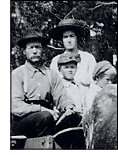 In most of America, the era of covered-wagon journeys was over by 1900. But in Minnesota, the availability of Indian land spurred a second wave of pioneer settlement even after the turn of the century.
Here is the story of Maude Baumann and her
family's pioneer trek through the state in 1900.
In most of America, the era of covered-wagon journeys was over by 1900. But in Minnesota, the availability of Indian land spurred a second wave of pioneer settlement even after the turn of the century.
Here is the story of Maude Baumann and her
family's pioneer trek through the state in 1900.
|
|
March
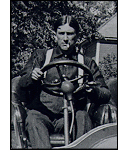 In 1896, a new contraption appeared at the Minneapolis bicycle convention. The mysterious machine looked like a horse carriage but it was powered by electricity and could reach the dizzying speed of 15 miles an hour.
Just over 100 years ago, skeptical citizens in Minneapolis and St. Paul predicted this new "automobile" was just a passing fad, but a sickly 15-year-old boy in Northfield, Minnesota, began drawing up plans for his own model.
In 1896, a new contraption appeared at the Minneapolis bicycle convention. The mysterious machine looked like a horse carriage but it was powered by electricity and could reach the dizzying speed of 15 miles an hour.
Just over 100 years ago, skeptical citizens in Minneapolis and St. Paul predicted this new "automobile" was just a passing fad, but a sickly 15-year-old boy in Northfield, Minnesota, began drawing up plans for his own model.
|
|
February
 A Minnesota Century pieces together two sets of 100-year-old
predictions of what Minneapolis and St. Paul will look like in the year 2000.
The accounts are taken from the pages of The Saint Paul Pioneer Press and The
Minneapolis Journal on January 1st, 1900. The rivalry that has always existed
between the two cities was especially strong toward the end of the 19th century,
and is very prevalent in each prediction.
A Minnesota Century pieces together two sets of 100-year-old
predictions of what Minneapolis and St. Paul will look like in the year 2000.
The accounts are taken from the pages of The Saint Paul Pioneer Press and The
Minneapolis Journal on January 1st, 1900. The rivalry that has always existed
between the two cities was especially strong toward the end of the 19th century,
and is very prevalent in each prediction.
|
|
January
 Americans
often remember the battle of Wounded Knee in South Dakota as the last armed
conflict between the U.S. Army and American Indians. But a forgotten battle
8 years later on the Leech Lake Indian reservation in Minnesota actually holds
that distinction. Americans
often remember the battle of Wounded Knee in South Dakota as the last armed
conflict between the U.S. Army and American Indians. But a forgotten battle
8 years later on the Leech Lake Indian reservation in Minnesota actually holds
that distinction.
|
Produced by: Annie Feidt, Sasha Aslanian and Kate Kuhn.
Editor: Stephen Smith, Host: Lorna Benson
The Minnesota Century Project on MPR is supported by Sarah
Kinney Professional Real Estate Services, matching people with property for
21 years. Coldwell Banker/Burnet, Crocus Hill Office.
|
|




 The turn of the century was a troubling, violent time for African-Americans in this country. Just decades after the end of slavery, blacks faced widespread discrimination, barriers to voting, and the terror of lynch mobs.
Frederick McGhee was a little-known figure whose life as a civil-rights advocate set the stage for this century's most influential black civil rights organization: the NAACP.
The turn of the century was a troubling, violent time for African-Americans in this country. Just decades after the end of slavery, blacks faced widespread discrimination, barriers to voting, and the terror of lynch mobs.
Frederick McGhee was a little-known figure whose life as a civil-rights advocate set the stage for this century's most influential black civil rights organization: the NAACP.









